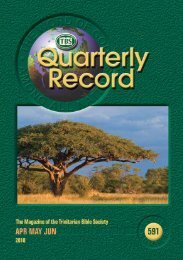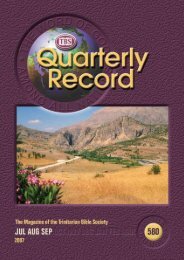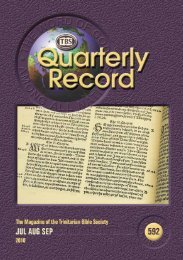TBS Quarterly Record 596 - Trinitarian Bible Society (Australia)
TBS Quarterly Record 596 - Trinitarian Bible Society (Australia)
TBS Quarterly Record 596 - Trinitarian Bible Society (Australia)
- No tags were found...
Create successful ePaper yourself
Turn your PDF publications into a flip-book with our unique Google optimized e-Paper software.
Issue Number: <strong>596</strong> – July to September 20111611? The <strong>Bible</strong> is indeed preserved, but notin one translation. God has always providedHis Word for His people.Dr Moorman responded by saying thatChrist had promised to preserve His Wordand words. Thus, if the Critical Text is theauthentic one, would it not seem strangethat we have not had the Word of God untilthe 1800s, when it was finally restored usingtwo nearly pristine, unused manuscriptswhich differ from everything else we haveever had? Regarding Revelation 16.5,according to Dr Moorman, Robinson in hiswork on the Byzantine Text lists over onehundred such hybrid passages which givefull evidence of their authenticity.• After the DebateFollowing the debate, several blogs andthreads on Internet forums have discussedthe findings. Of particular interest is theKJV Only Debate Blog. 3 It was noted thatErasmus had access to readings from CodexVaticanus, one of the two main manuscriptsunderlying the Critical Greek Text, but wasunwilling to use them—his comments inthe preface to the 1535 edition of his Greektext indicate that he was convinced thatVaticanus was made to conform to the LatinVulgate.As to the Pilgrim Fathers’ view of theAuthorised Version, the Pilgrim HallMuseum 4 shows evidence that the AVwas used by some of the early colonists(despite many of them having been in exilein the Netherlands and more accustomedto the English <strong>Bible</strong> produced on theContinent: the Geneva). John Alden, oneof the founders of the Plymouth Colonyin what would become Massachusettsand believed to have been the first of thePilgrims to disembark at Plymouth Rock in1620, carried with him an AV, which is nowhoused in the museum.Regarding the plethora of Englishtranslations now available, considerationwas given as to what the AV translatorswould do if they were alive today. Wouldthey not revise their own work? But thetranslators themselves said that their desirewas to make one principal translation,accurately translated from the Biblicallanguage texts before them and withreference to other translations of the period,one version ‘not justly to be exceptedagainst’. 5 One would think that they wouldbe aghast at what we now have before us.One argument used by Critical Textproponents against the Textus Receptusis that Erasmus only used six manuscriptsin the production of his first edition. Onthe other hand, the Critical Text is eclectic,taking into account all the availablemanuscripts and using text-criticalprinciples in determining which of thevariant readings is likely to be the original.However, its editors essentially ignore themajority of the 5,500 available manuscripts(most of which are of the Byzantine texttype)in favour of fifty of the Alexandriantype; and of those fifty they focus verystrongly on two old manuscripts (Sinaiticusand Vaticanus) which differ betweenthemselves in thousands of instances.Additionally, although Erasmus indeedused few manuscripts for his first edition, heand others used many more for their latereditions, and these manuscripts are muchmore representative of the majority thanthose used for the Critical Text.Four passages of Scripture in particular were29





![The Love of the Truth [pdf] - Trinitarian Bible Society](https://img.yumpu.com/49788277/1/184x260/the-love-of-the-truth-pdf-trinitarian-bible-society.jpg?quality=85)
![Bible Word List and Reading Plan [pdf] - Trinitarian Bible Society](https://img.yumpu.com/46882563/1/177x260/bible-word-list-and-reading-plan-pdf-trinitarian-bible-society.jpg?quality=85)
![Click to Download Document [pdf] - Trinitarian Bible Society](https://img.yumpu.com/44904205/1/184x260/click-to-download-document-pdf-trinitarian-bible-society.jpg?quality=85)
![Download Document [pdf] - Trinitarian Bible Society](https://img.yumpu.com/44584740/1/184x260/download-document-pdf-trinitarian-bible-society.jpg?quality=85)


![Download Document [pdf] - Trinitarian Bible Society](https://img.yumpu.com/41007786/1/184x260/download-document-pdf-trinitarian-bible-society.jpg?quality=85)
![Click to Download Document [pdf] - Trinitarian Bible Society](https://img.yumpu.com/40894484/1/188x260/click-to-download-document-pdf-trinitarian-bible-society.jpg?quality=85)


![Download Document [pdf] - Trinitarian Bible Society](https://img.yumpu.com/39425868/1/184x260/download-document-pdf-trinitarian-bible-society.jpg?quality=85)
![Download Document [pdf] - Trinitarian Bible Society](https://img.yumpu.com/39425821/1/184x260/download-document-pdf-trinitarian-bible-society.jpg?quality=85)